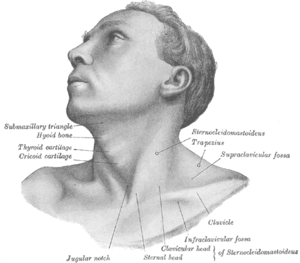Torticollis
| Torticollis | |
|---|---|
 |
|
| The muscles involved with torticollis | |
| Classification and external resources | |
| Specialty | Orthopedics |
| ICD-10 | M43.6 |
| ICD-9-CM | 723.5 |
| DiseasesDB | 31866 |
| MedlinePlus | 000749 |
| eMedicine | emerg/597 orthoped/452 |
| Patient UK | Torticollis |
| MeSH | D014103 |
Torticollis, also known as a crick in the neck, wry neck or loxia, is a dystonic condition defined by an abnormal, asymmetrical head or neck position, which may be due to a variety of causes. The term torticollis is derived from the Latin words tortus for twisted and collum for neck.
The most common case has no obvious cause, and the pain and difficulty with turning the head usually goes away after a few days, even without treatment.
The underlying anatomical distortion causing torticollis is a shortened sternocleidomastoid muscle. This is the muscle of the neck that originates at the sternum and clavicle and inserts on the mastoid process of the temporal bone on the same side. There are two sternocleidomastoid muscles in the human body and when they both contract, the neck is flexed. The main blood supply for these muscles come from the occipital artery, superior thyroid artery, transverse scapular artery and transverse cervical artery. The main innervation to these muscles is from cranial nerve XI (the accessory nerve) but the second, third and fourth cervical nerves are also involved. Pathologies in these blood and nerve supplies can lead to torticollis.
Torticollis is a fixed or dynamic tilt, rotation, or flexion of the head and/or neck. The type of torticollis can be described depending on the positions of the head and neck.
A combination of these movements may often be observed. Torticollis can be a disorder in itself as well as a symptom in other conditions.
Other symptoms include:
A multitude of conditions may lead to the development of torticollis including: muscular fibrosis, congenital spine abnormalities, or toxic or traumatic brain injury. A rough categorization discerns between congenital torticollis and acquired torticollis.
The cause of congenital muscular torticollis is unclear. Birth trauma or intrauterine malposition is considered to be the cause of damage to the sternocleidomastoid muscle in the neck. Other alterations to the muscle tissue arise from repetitive microtrauma within the womb or a sudden change in the calcium concentration in the body which causes a prolonged period of muscle contraction.
Any of these mechanisms can result in a shortening or excessive contraction of the sternocleidomastoid muscle, which curtails its range of motion in both rotation and lateral bending. The head typically is tilted in lateral bending toward the affected muscle and rotated toward the opposite side. In other words, in the direction towards the shortened muscle with the chin tilted in the opposite direction.
...
Wikipedia
